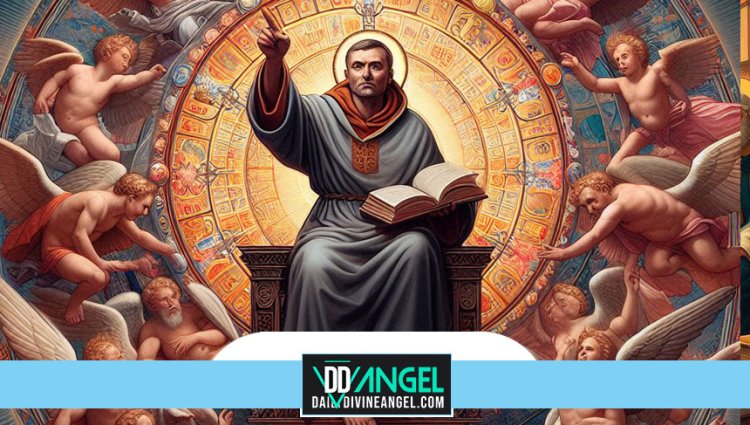Thomas Aquinas and the hierarchy of angels.
How to Understand Thomas Aquinas and the Hierarchy of Angels - Thomas Aquinas and the hierarchy of angels. Explaining the truths of religion. Defending the faith against objections.

Thomas Aquinas lived in the 12th century. He turned into a Dominican friar; however, he is remembered above as keen on his deserves as a theologian, philosopher, and health practitioner of the Church. This is the merit of getting recognized as the way to discover the point of union and combine classical and Hellenistic philosophy with Christian theology, and of having outlined the ideas of Western Christian doctrine inside the center for a while, with pillars of ideas that remain legitimate today.
Son of a noble Sicilian family, became initiated into ecclesiastical research at a very young age and was dispatched via his mother and father to the Abbey of Montecasino. Later, barely a teen, he moved to Naples and enrolled in the university created by means of Frederick II, King of Sicily, for the nobles and scholars of his Empire. Here he also took vows in the Dominican order, contravening the instructions of his family, who hoped to make him someday abbot of Monte Cassino. To persuade him to exchange his plans, his family imprisoned him for 2 years in the fort of Monte San Giovanni Campano; however, in the end, they needed to renounce themselves and ship him again to Naples.
Thomas persisted in his research in Rome, Paris, and Cologne, becoming a scholar and assistant to Albert the notable, a grasp of theology, who deeply transmitted his knowledge to him throughout those important years of his training. It changed into Alberto Magno, who introduced him to coaching at the College of Paris, although he turned into the most effective 27-year-old antique. Here he turned into able to research and respect the work of Aristotle, of whom he could end up a high-quality student and commentator. This is the advantage of having recognized how to readapt Aristotelian ideas.
A christian attitude
Returning to Italy, he taught in Orvieto, then in Rome, where he endured analyzing Aristotle's paintings with his translator and pal William of Moerbeke, and once more in Paris, wherein he wrote some of the most crucial works of Aristotle. In the meantime, he dedicated himself to reorganizing the schools of the Dominican Order and teaching theology.
In the closing period of his existence, Thomas Aquinas lived in Santo Domingo Mayor, Naples, dividing his time between looking at and praying. At some point, while celebrating Mass within the chapel of Saint Nicholas in the church of Saint Michael the Archangel in Morphisa, Thomas had a vision that upset him so much that he stopped writing. "I cannot, due to the fact that the entirety of what I have written is like straw to me compared to what has been found out to me," he discovered to his friend and secretary Reginaldo da Piperno. He died rapidly after, at the age of forty-nine, and his remains are preserved inside the Dominican church of the Jacobins in Toulouse, while different relics are scattered throughout diverse Italian churches.
At the basis of St. Thomas's philosophy is the idea that faith and cause should work together to lead to reality. Man can realize the truths of the arena through reason and philosophy, but the handiest divine revelation elevates reason to truth and perfection. Therefore, the motive serves as a basis:
Demonstrating the preambles of religion.
Explaining the truths of religion. Defending the faith against objections.
In his willingness to combine faith and motive, Saint Thomas Aquinas came here to demonstrate the existence of God on a rational basis.
Furthermore, stimulated by Aristotelian concepts, Thomas maintained that the guy is the fruit of the union of the soul and the body, but he delivered to Aristotle that the soul has been created "inside the photograph and likeness of God" in such a way that it comes completely from He and, like Him, is transcendent, immaterial, and yet thoroughly contained in each part of the frame.
The Summa Theology
In his brief lifetime, Saint Thomas wrote a substantial number of theological and philosophical works. a few of the most famous are: the Summa contra gentiles, 4 books supposed to give an explanation for the veracity of the Catholic faith to the Gentiles, this is, to the pagans, with truths that concern motive by myself blended with divine truths; the Scriptum super books Sententiarum, the observation at the Sentences of Peter Lombard, a treatise on medieval theology on the basis of Scholasticism; and the Summa Theologiae, the Summa Theologiae, perhaps his most critical paintings.
Written inside the remaining years of Thomas's lifestyles and left unfinished, it's far taken into consideration the most important treatise on medieval theology ever written.
The work takes as its starting point the Summa contra Gentiles, but from the beginning it demonstrates a more theological than apologetic character, mentioning numerous authors of antiquity, from Aristotle to Saint Augustine of Hippo, from Peter Lombard to Pseudo Dionysius the Areopagite, from Avicenna. to Moses Maimonides.
What's Your Reaction?




















